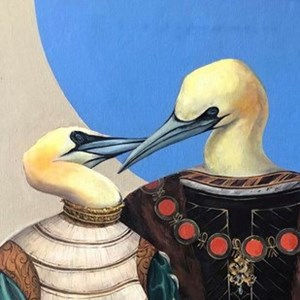
"I find a lot of inspiration in the works by Old Masters, especially the European artists of the 16th and 17th Century. These works appear perfect for their time. Their value lies in their splendour and in a special mixture of symbols for the viewer. In order to emphasize and convey the idea of my paintings, I use symbols".
Image: Olga Karika, Opal
Olga is a young Ukrainian artist who reflects on double standards and wrongful interpretations through her art. She does so in order to encourage the viewer to start a dialogue with their inner self. Olga’s main inspiration is the notion of a so called "eternal beauty" that can be firm and invariable but can hide a deeper truth.
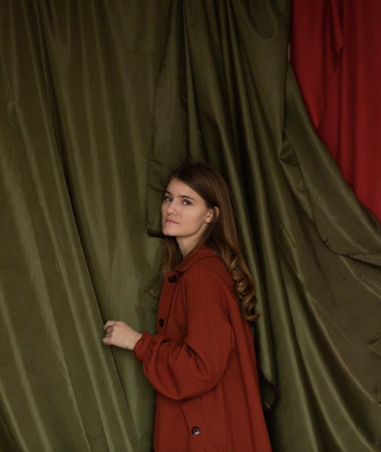 Olga Karika, image courtesy to the artist
Olga Karika, image courtesy to the artist
Art Dependence (AD): How do you describe your style of painting?
Olga Karika (OK): It lays on a sort of junction of old and new. I find a lot of inspiration in the works by Old Masters, especially the European artists of the 16th and 17th Century. These works appear perfect for their time. Their value lies in their splendour and in a special mixture of symbols for the viewer. In order to emphasize and convey the idea of my paintings, I use symbols. In the history of art, symbolism has been used in its purest form in works depicting mythological subject matter, as well as Christian ones. I prefer the symbolism of Christian paintings, as the biblical subjects have a large number of canons and are more vividly revealed in the Middle Ages.
AD: Your birdy images lead to something beyond just the mechanics of frame arrangements. They seem to be integral to larger discussion. Tell us about the world in which these works were created.
OK: Every artwork is a sort of dialogue with my viewer. I enrich the works with characters in certain situations, as well as with symbols in order to emphasize the idea and purpose of the work. At the same time, the viewers may interpret my works in a variety of ways and in a sense, they are open to interpretation. I find it fascinating when people find their own meaning in my works. The idea of combining a bird and the medieval image of people was born as a paradox - a symbol of freedom (bird) in the darkest and most limited times in terms of temper (the Middle Ages.) Thus, the idea is that thoughts that are in our head are not visible. That is pure freedom. However, often our thoughts are determined by the framework set by the society, stereotypes and other imposed tricks - which triggers a funny mechanism of "thinking that common thoughts are your own".
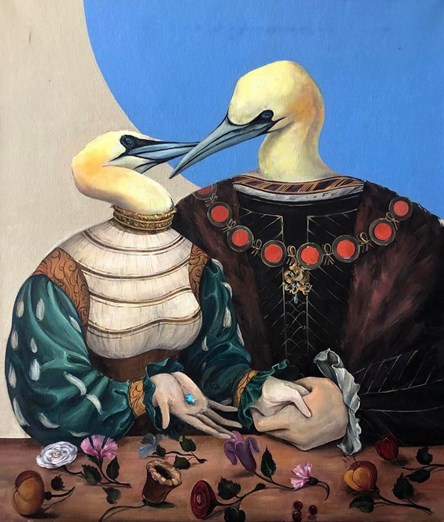 Olga Karika, Opal, artwork is on sale at The Art Lodge Gallery
Olga Karika, Opal, artwork is on sale at The Art Lodge Gallery
AD: Colour and light play a strong role in your work. Whatare your basic principles?
OK: I love rich, deep colours, and am captivated by the aesthetics of art museums. Also, I am fascinated by the period of mature Gothic which has a special technique embedded within it. I like the inimitable plasticity of the medieval characters and the naive volume of the transferred objects. In my opinion, there is a lot of integrity in this.
AD: Is your art a self-expression or a form of description?
OK: Surprisingly, my first work featuring a bird and a person was a self-portrait. I can’t answer exactly why and how I came to this. I've never painted people, and I've always been more interested in texture and colour rather than the subject matter itself. But I think during that period there were many changes in my life, and I somehow dived deeper and came up with an image like this. Since then, I have always been present in the paintings, but as you can see, every time in different guises and with a different story to tell.
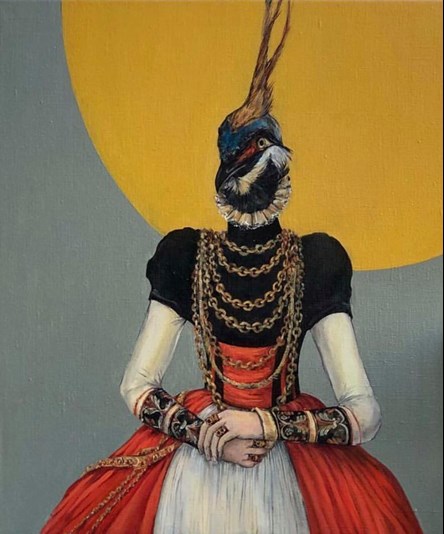 Olga Karika, Phasanius, artwork is on sale at The Art Lodge Gallery
Olga Karika, Phasanius, artwork is on sale at The Art Lodge Gallery
AD: Where did you study painting and drawing?
OK: I have been drawing since I was 5. I was sent to an art school, where I learnt the basics - drawing, sculpture, painting, composition, art history and everything else. But the turning point was when I started attending oil painting classes. I was 13 at the time. My immediate thought was - this is my material! And till this day, I paint exclusively in oil. Later I received higher education in Architecture at the National Architecture Academy. I even worked as an architect for some time, I enjoyed it, but I'm glad that I did not choose that path for myself. At the moment, I work in graphic and web design, I do enjoy it a lot, although, I still feel that working in my studio as an artist and teacher makes me the most happy.
AD: Do you believe an artist needs to get a proper art education
or can they succeed by studying alone?
OK: This is a complex issue. Now art has become available to everyone and it is really much more difficult to define what art is, because everyone can do it. The ideal formula for me is idea + technique + own style. That said, I think that foundation is crucial. Basically, all great artists who chose the path of an abstractionist, naive art, impressionism did this not because of the inability to draw, but in the name of their ideas and certain social intentions.
AD: Do you keep a sketchbook or a journal of your daily life ideas to record them at the moment of encounter?
OK: I prefer to create a mood board for the idea that appears in my head; I think my paintings are sort of based on the principle of collage. I rarely prepare a complete sketch for a painting at once. I collect different images of the objects that I need for my ideas - jewellery, stones, dresses, birds, plants. And they somehow I add them up in my head. I love the feeling when a certain image in my mind comes to life.
AD: Do you visit art museums and galleries for the inspiration
or do you look at much art by other artists?
OK: I love museums. I’ve methodically visited them for five years. I had a goal to visit all the significant capitals of Europe before I turn 25, and if it were not for the pandemic, I would have achieved it.
I’ve got two countries left-Belgium and Sweden. They are my endless sources of inspiration and I usually refer to the Old Masters of the Middle Ages – by collecting images, interesting details and references. The rest of the art periods are for personal pleasure. In Kyiv, I often visit exhibitions of my friends who are artists too and artists who I’m yet to meet. It is always interesting to see who is behind the paintings, what kind of person he or she is.
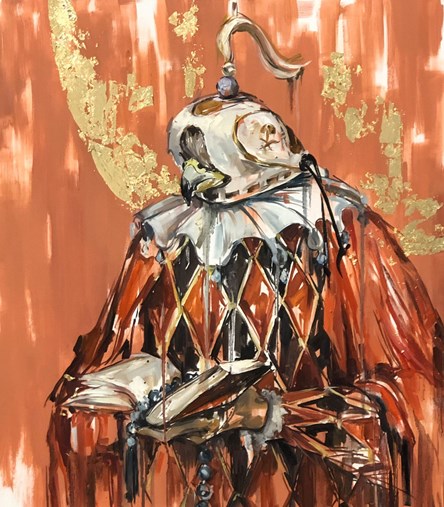 Olga Karika, Knowledge,artwork is on sale at The Art Lodge Gallery
Olga Karika, Knowledge,artwork is on sale at The Art Lodge Gallery
AD: Describe the people who buy your works.
OK: I would say these are really wonderful people. I admire them, as often they’re entrepreneurs who nurture their businesses and grow them. Also, our tastes are often similar – the love for the old, luxury, for the mysterious past. I could probably say that my paintings are to some extent for exceptional people - they have a pronounced identity, it is difficult to rank them in the segment “I only buy art to decorate the wall of my house”. There is often love and interest in the story, and the details.
AD: Are you planning any exhibitions after lockdown is over?
OK: Yes, of course. Although I did not have enough time for a whole new project. I did not paint during the quarantine.
Now as the quarantine has been lifted in Ukraine, I am starting to paint again, and I have decided to start more art series. Two are already in my head and I am sure there will be more.
All artworks are available to purchase at the Art Lodge Gallery.

ArtDependence Magazine is an international magazine covering all spheres of contemporary art, as well as modern and classical art.
ArtDependence features the latest art news, highlighting interviews with today’s most influential artists, galleries, curators, collectors, fair directors and individuals at the axis of the arts.
The magazine also covers series of articles and reviews on critical art events, new publications and other foremost happenings in the art world.
If you would like to submit events or editorial content to ArtDependence Magazine, please feel free to reach the magazine via the contact page.